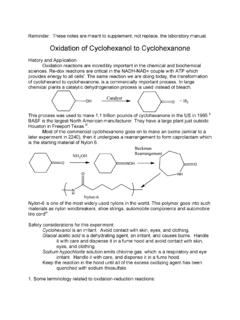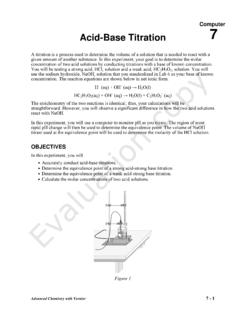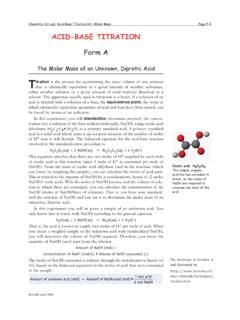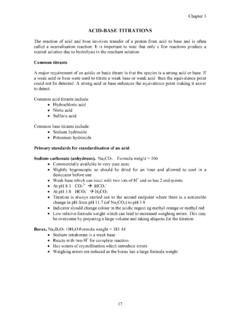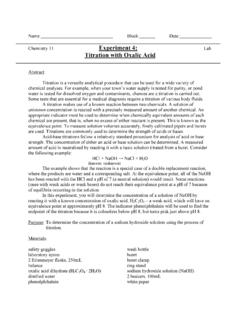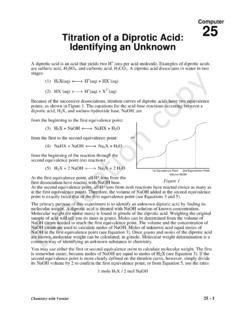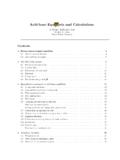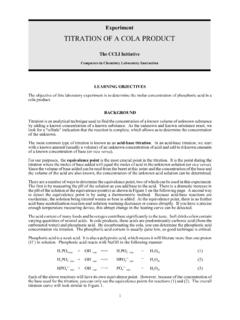Transcription of 4 Titration Curve of an Amino Acid - Xavier …
1 4 Titration Curve of an Amino acid 7H Objectives: A) To determine the Titration Curve for an Amino acid and B) to use this Curve to estimate the pKa values of the ionizable groups of the Amino acid and the Amino acid s pI. Introduction: A Titration Curve of an Amino acid is a plot of the pH of a weak acid against the degree of neutralization of the acid by standard (strong) base . Consider the ionization of a weak organic acid such as acetic acid by NaOH. CH3 COOH(aq)+ NaOHCH3 COO-Na+H2O+ As more of the strong base (titrant) is added to the aqueous solution, more of the weak acid is converted to its conjugate base .
2 During this process, a buffer system forms and the pH of the system will follow the Henderson-Hasselbalch relationship. The Titration Curve of the neutralization of acetic acid by NaOH will look like this: pOH-equivalentsSimple Amino acidAcidic Amino acidBasic Amino acidpOH-equivalents7 HSimple Amino acidAcidic Amino acidBasic Amino equivalentspH = pKaEquivalents of equivalentspH = pKaEquivalents of BasepHWhen a weak monoprotic acid is titrated by a base , a buffer system is formed. The pH of this system follows the Henderson-Hasselbalch equation: This Curve empirically defines several characteristics (the precise number of each characteristic depends on the nature of the acid being titrated): 1) the number of ionizing groups, 2) the pKa of the ionizing group(s), 3) the buffer region(s).
3 Equivalents of BasepH100% HA100% A-90% HA10% A-90% A-10% HA50% HA50% A-pH = pKa;pH = pKa - 1;; pH = pKa + 1 Buffer regionEquivalents of BasepH100% HA100% A-90% HA10% A-90% A-10% HA50% HA50% A-pH = pKa;pH = pKa - 1;; pH = pKa + 1 Buffer region Based on the number of plateaus on a Titration Curve , one can determine the number of dissociable protons in a molecule. The one plateau observed when acetic acid is titrated indicates that it is a monoprotic acid ( , has only one dissociable H+). Many organic acids are polyprotic (have > one dissociable H+). The protein building blocks, Amino acids, are polyprotic and have the general structure H3 NCCOOHHR + The majority of the standard Amino acids are diprotic molecules since they have two dissociable protons: one on the alpha Amino group and other on the alpha carboxy group.
4 There is no dissociable proton in the R group. This type of Amino acid is called a simple Amino acid . A simple Amino acid is electrically neutral under physiological conditions. NOTE: Under this definition it is possible to have a simple Amino acid which is triprotic. Which of the 20 common or standard Amino acids are simple & triprotic? Ionization of a diprotic Amino acid will proceed as follows: H3 NCCOOHHR +H3 NCHRCOO- ++ H+H2 NCHRCOO- H3 NCHRCOO- ++ H+Dissociation 1:Dissociation 2: The order of proton dissociation depends on the acidity of the proton: that which is most acidic (lower pKa) will dissociate first.
5 Consequently, the H+ on the -COOH group (pKa1) will dissociate before that on the -NH3 group (pKa2). The Titration Curve for this process looks similar to the following: Equivalents of BasepHpH = pKa2pH = pKa1pH = pIEquivalents of BasepHpH = pKa2pH = pKa1pH = pI This Curve reveals, in addition to the same information observed with a monoprotic acid , an additional characteristic of polyprotic acids and that is the pH at which the net charge on the molecule is zero. This pH defines the isoelectric point (pI) of the molecule, a useful constant in characterizing and purifying molecules. Using a Titration Curve , the pI can be empirically determined as the inflection point between the pKa of the anionic and cationic forms.
6 Mathematically, the pI can be determined by taking the average of the pKa for the anionic and cationic forms. The ionic form of the molecule having a net charge of zero is called the zwitterion. A few Amino acids are classified as triprotic. This is because, in addition to the ionizable protons of the -COOH and -NH3 groups, they also have a dissociable proton in their R group. Although triprotic Amino acids can exist as zwitterions, under physiological conditions these Amino acids will be charged. If the net charge under physiological conditions is negative, the Amino acid is classified as an acidic Amino acid because the R group has a proton that dissociates at a pH significantly below pH 7.
7 The remaining triprotic Amino acids are classified as basic Amino acids due to a) their having a net positive charge under physiological conditions and b) an R group dissociable proton with a pKa near or greater than pH 7. Titration curves for triprotic Amino acids generate the same information as those for the diprotic Amino acids. The pI for a triprotic Amino acid can be determined graphically, although this is somewhat more challenging. Graphical determination, as was the case with the diprotic acids, requires one to know the ionic forms of the Amino acid and finding the inflection point between the cationic and anionic forms.
8 Mathematically, the pI for an acidic Amino acid is the average of pKa1 and pKaR (the pKa of the dissociable proton in the R group); for a basic Amino acid , it is the average of pKa2 and pKaR. Amino acid Classification Based on Number of Dissociable Protons 1-Letter code 3-Letter code Name Mnemonic help for 1-letter code* Classification A Ala Alanine Alanine Simple C Cys Cysteine Cysteine Simple D Asp Aspartate AsparDic acid Acidic E Glu Glutamate GluEtamic acid Acidic F Phe Phenylalanine Fenylalanine Simple G Gly Glycine Glycine Simple
9 H His Histidine Histidine Basic I Ile Isoleucine Isoleucine Simple K Lys Lysine before LBasic L Leu Leucine Leucine Simple M Met Methionine Methionine Simple N Asn Asparagine asparagiNe Simple P Pro Proline Proline Simple Q Gln Glutamine Q-tamine Simple R Arg Arginine aRginine Basic S Ser Serine Serine Simple T Thr Threonine Threonine Simple V Val Valine Valine Simple W Trp Tryptophan tWo rings Simple Y Tyr Tyrosine tYrosine Simple *EG Schulz and RH Schirmer.
10 Principles of Protein Structure (1979), p. 2. Use of the pH meters. 1. Plug in the meter 2. By GENTLY twisting and pulling remove the cap from the electrode. Be careful not to spill the electrode storage solution. 3. Open the hole at the top of the electrode, there is a plastic door that slides open to expose hole 4. Rinse the electrode with deionized water 5. Standardize the meter (steps 6 11) 6. If the display reads a small number 4 and/or 7 press Set up 7. When screen reads clear press enter (this removes old standards) 8. Place electrode in pH buffer (pink) 9. Press Standardize You should see numbers 2, 4, 7, 10, 12 and an icon of an electrode blinking When meter is standardized an upper case S will appear in a box on the display, followed by (pH 100) also a small number 4 should appear and stay.

